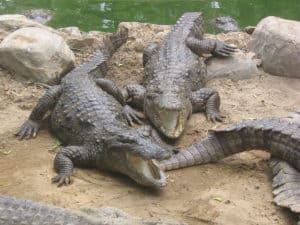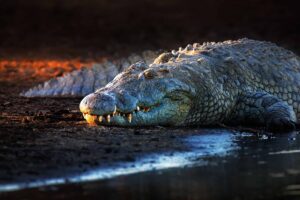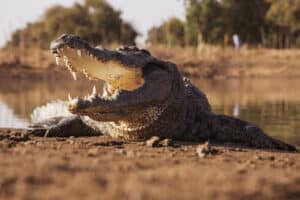Anyone living in alligator or crocodile territory knows about the vicious speed of surprise attacks. Using caution around the water’s edge and protecting any pets becomes paramount. However, even when locals and visitors exercise caution, it doesn’t always help prevent attacks. And unlike attacks from other predators (like bears), there does not appear to be a rhyme or reason for crocodile attacks. There is one crocodile in particular who has achieved legendary status among locals. But not for a good reason. This particular animal is the world’s most dangerous crocodile. So, who is he, and where does he live?
The article below will introduce you to this dangerous animal, cover some basic crocodile facts, and take a brief glimpse at other animals that live in the same region. So keep reading to learn about the world’s most dangerous crocodile.
Meet ‘Gustave’
‘Gustave’ is known by locals as a man-eater. And that is because rumor has it that he is behind over 200 fatal attacks on humans. What has some researchers stumped, however, is that ‘Gustave’ doesn’t always eat his victims. Often he kills and then simply abandons the bodies.
The ferocious predator is a Nile crocodile (Crocodylus niloticus) living in Burundi. He makes his way between the northern edge of Lake Tanganyika and the Ruzizi River.
‘Gustave’ got his name from one of the herpetologists who studied him. In the late 1990s, Patrice Faye bestowed the moniker on the giant animal. But the interesting thing is that no one is sure about how large the crocodile actually is. He has never gotten caught, despite many attempts. The film Capturing the Killer Croc even documented one such attempt. It followed the efforts of researchers that spent two months attempting to capture him after two full years studying his habits. The documentary aired on PBS in 2004.
So all we have is rough estimates of size and age. Years ago, experts believed ‘Gustave’ was pushing 100 years old due to his estimated size. But shortly after making that determination, someone noticed he had all his teeth. So researchers adjusted his age estimate. They now believe that he is roughly 60 years old and still growing.
Scientists suggest he is about 20 feet (6.1 m) long and clocks in at more than 2,000 pounds (910 kg). He is readily identifiable not just by his size but also by his distinguishing characteristics. ‘Gustave’ has three bullet wounds and damage to his right shoulder blade. However, no one knows how he received those wounds.
Because he is so big, he has trouble hunting smaller prey like antelope, fish, and zebra. So he goes after animals like hippopotamus, buffalo, and sadly, people.
‘Gustave’ is so well-known and feared among locals that Hollywood even picked up on it. The movie Primeval is actually about the monstrous crocodile.
Some rumors suggest ‘Gustave’ died in 2019. But there is no photographic evidence, and no carcass ever got recovered.
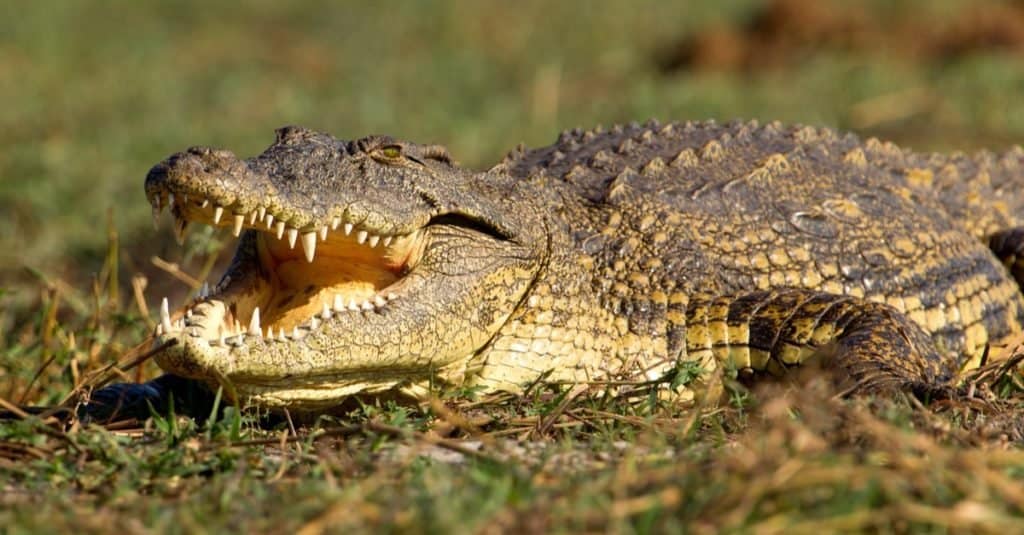
‘Gustave’ is a Nile crocodile that is considered the most dangerous crocodile. Locals refer to him as the “man-eater.”
©Gaston Piccinetti/Shutterstock.com
What Are Nile Crocodiles?
Nile crocodiles (like ‘Gustave’) are native to Africa and are freshwater reptiles. They prefer rivers, swamps, lakes, and marshlands. And are found in 26 African countries. The only living reptile larger than the Nile crocodile is the saltwater crocodile Crocodylus porosus.
Crocodiles typically grow between roughly 10 feet (2.94 m) and 14.5 feet (4.4 m). And they can weigh from 496 pounds (225 kg) to 914 pounds (414.5 kg). Their size does vary greatly between males and females, which are roughly 30% smaller on average. But these are just average sizes. Some Nile crocodiles up to 2,401 lb and 20 feet long have been seen.
The apex predators are not picky about their food. Prey of preference includes birds, other reptiles, fish, and mammals. Their powerful bite using conical and razor-sharp teeth gives them a death grip on prey, allowing the crocodile to drown their victims.
They have scaly, thick, armored skin that is difficult to pierce. Nile crocodiles can swim underwater for 30 minutes. And when they are inactive, they can stay under for up to 2 hours. They are incredibly fast swimmers, cruising up to 19 or 33 mph. And they are also capable of short bursts at just under 9 mph on land. The combination of these abilities allows them to launch unpredictable and sudden attacks upon prey.
Nile crocodiles are very social animals, but they do have a size-based hierarchy among the group.
Males breed every year. However, larger females usually only nest once every two or three years, when they lay larger clutches of eggs, up to 95. After the eggs get laid, the female crocodiles guard them. Hatchlings get protected as well but not provided for. They must hunt for themselves.
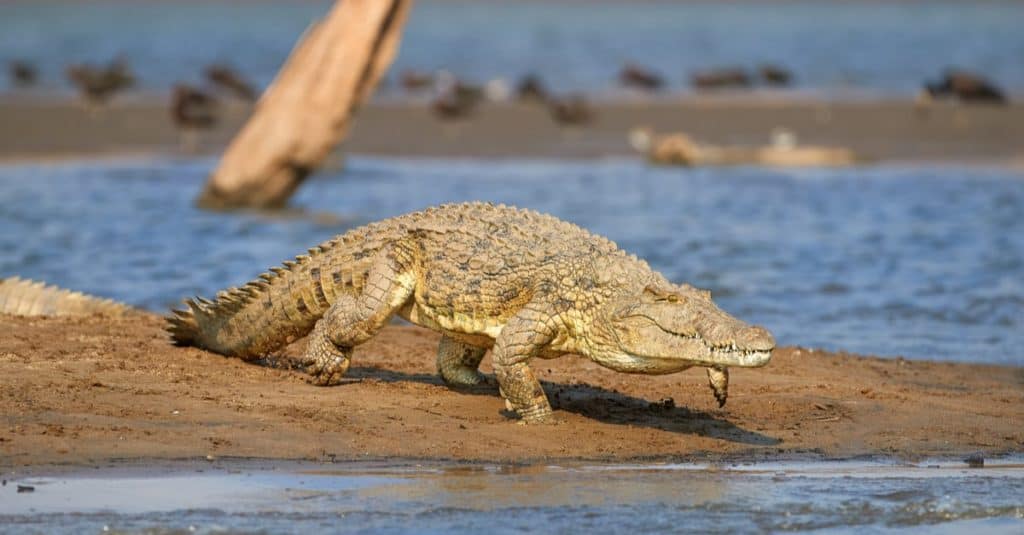
Nile crocodiles are enormous. The only repitle larger than these amazing animals is the saltwater crocodile.
©Martin Mecnarowski/Shutterstock.com
What Animals Live at Lake Tanganyika?
Since one of the primary places that ‘Gustave’ calls home is Lake Tanganyika, it would be helpful to see what other animals live nearby. The lakeshore is a biodiverse space, so the animals listed below are only a small sampling of those that live there.
Mammals
The selection of animals living around Lake Tanganyika is a fun collection. It includes bushy-tailed mongooses, plains zebras, olive baboons, red-tailed monkeys, vervet monkeys, brown greater Galagos, common hippopotamuses, ashy red colobuses, and rusty-spotted genet.
Birds
There are 15 spectacular species of birds living around the lake. They include striated herons, African gray hornbills, osprey, water thick-knees, African fish eagles, and European bee-eaters.
Reptiles
‘Gustave’ and his fellow Nile crocodiles are not the only reptiles gracing the banks of the lake. There are also Mt Rungwe Bush vipers, Nile Monitors, Speckle-lipped mabuyas, Eastern twig snakes, East African garter snakes, Finch’s agamas, and ringed water cobras.
Fish
The lake is famous for its finned inhabitants. There are over 50 species of fish living in Lake Tanganyika. But it is most notably known for its high concentration of cichlids. There are over ten varieties of cichlids in the lake!
Others
In contrast with the impressive collection of larger animals, there are fewer smaller critters in the area. Lake Tanganyika only has one observed amphibian (crowned bullfrog), three arachnid species, and 25 insect species.
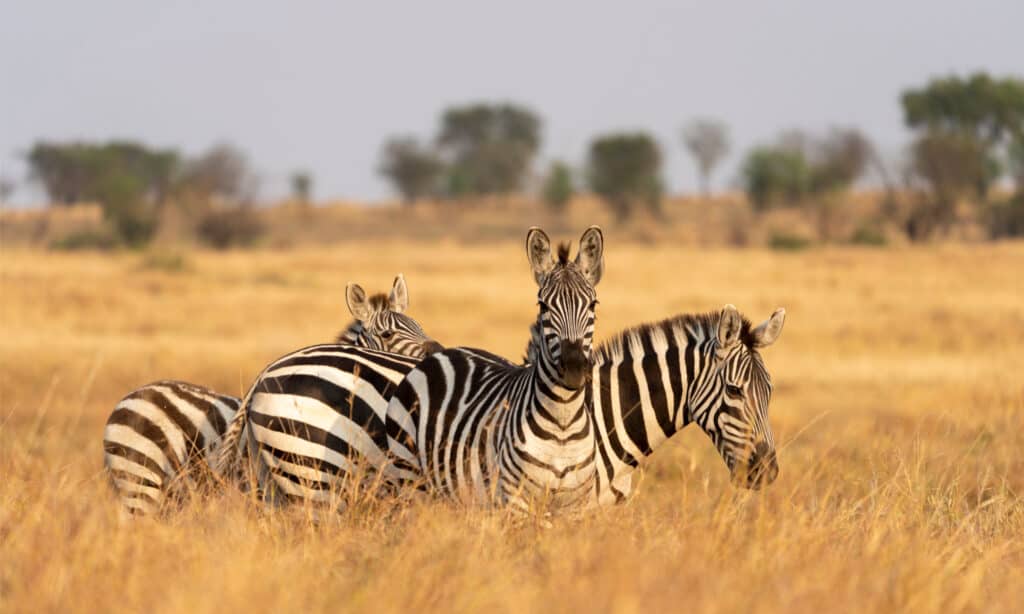
Zebras are one of the fascinating animals hanging out around Lake Tanganyika with ‘Gustave.’
©iStock.com/Cavan Images
Is a Crocodile More Dangerous Than a Lion?
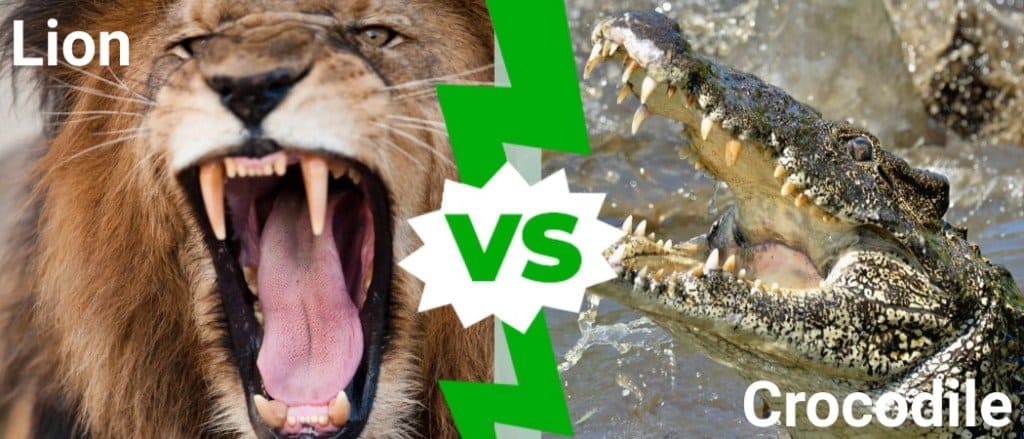
A crocodile has an incredibly strong bite force that is considered one of the strongest in the world. Its bite force is measured in pounds per square inch (psi), and this reptile has one that is 3,700 pounds. This psi is three-and-a-half times more powerful than a lion, whose bite force is 1,000, and 25 times more powerful than a human. Lions may seem quite dangerous, and they are, but they are responsible for fewer deaths worldwide than that of a crocodile.
Lions have killed about 250 people, while this reptile kills around 1,000 humans per year. Lions aren’t the only animals that crocodiles are more dangerous than. A crocodile attack is not only considered more deadly, but attacks are also more frequent. Even a shark, with a higher bite force of 4,000 psi, isn’t considered as deadly as a crocodile, and the yearly deaths attributed to sharks are comparatively lower, around 10.
The photo featured at the top of this post is © Mari Swanepoel/Shutterstock.com
FAQs (Frequently Asked Questions)
What eats Nile crocodiles?
These animals are apex predators and therefore do not have any animals that hunt the adults in the species. However, hatchlings (or baby crocodiles) are susceptible to getting hunted by other animals. Some predators that seek out baby crocodiles include African fish eagles, honey badgers, Nile monitor lizards, and snakes.
Are Nile crocodiles in Florida?
While Florida is well-known for its native alligator population, the state also has some crocodiles. And unfortunately, Nile crocodiles have been spotted in Florida. It is considered an invasive species.
What is special about Lake Tanganyika?
Nile crocodiles, including Gustave, inhabit Lake Tanganyika. But that’s not what makes this body of water so special. This impressive lake is the second deepest lake in the world, the oldest lake in the world, and the second largest (by volume) in the world.
Are there jellyfish in Lake Tanganyika?
Yes, actually. There is one documented jellyfish species living in the lake. It is Limnocnida tanganjicae.
Thank you for reading! Have some feedback for us? Contact the AZ Animals editorial team.




